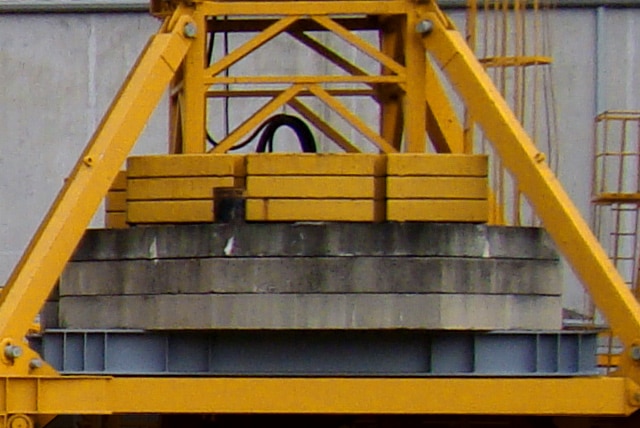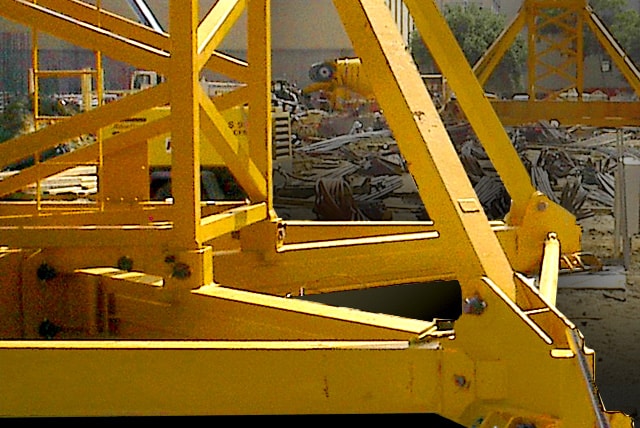Ръководство за кулокран

How does a tower crane work?
Tower cranes are seen on almost every major construction site throughout the world. These machines are built to lift heavy loads efficiently and safely. A modern tower crane consists of three major sections: the base, the tower mast, and the slewing unit. Roll-over the diagram below to learn more about major components of a tower crane.
+Video | NEXT »
Horizontal Jib
The jib extends horizontally at various lengths depending on the model and configuration of the crane. A trolley attached to the underside of the jib moves loads in and out from the cranes center axis. Hoist and trolley lines run throughout the jib enabling vertical and horizontal movement of the load. Rotation of the jib is achieved by employing the "slewing" action.
+Diagram +Video | NEXT »
Trolley
To move a load in and out from the cranes center axis a trolley is employed along the underside of the horizontal jib. Powering the trolley is the trolley drive mounted on the horizontal jib. A cable from the trolley drive runs through the jib and is attached to the trolley. A trolley then controls the loads radial movement and helps stabilize the load.
+Diagram | NEXT »
Hook Block
A hook or hoist is attached to the hook block assembly. Hook block assemblies house a series of sheaves and pulleys that carry the rope. The block provides greater flexibility and facilitates the lifting of a load. The primary function being for the free rotation and positioning of a load.
+Diagram | NEXT »
Counter Jib
A cranes drives, drums, gears, electronics, and counter-weights are found on the counter-jib platform. Located behind the operator cab, the counter-jib provides a balancing force to the load on the horizontal jib. Drives, drums and electronics are located to the rear of the counter-jib to maximize torque and for ease of maintenance.
+Diagram +Video | NEXT »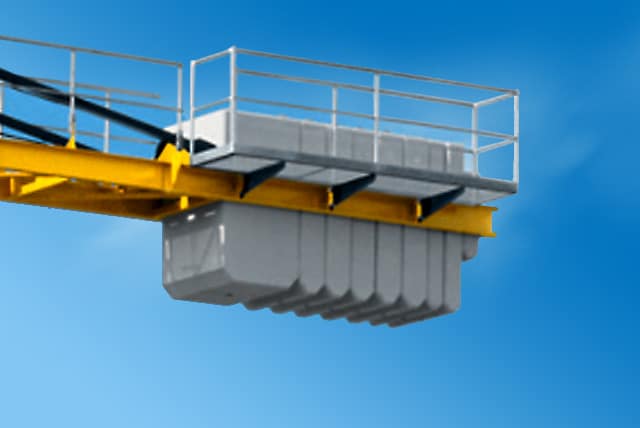
Counterweight
Balancing the forces on the crane caused by the load is a primary function of the counterweight. Counterweights are fabricated from concrete and come in modular units. The number of counterweights depends on the expected max load capacity, jib length and tower height.
+Diagram | NEXT »
Hoist Unit
The hoist unit houses the hoist drum, gear box, gear shift, brake, and supporting components. Typical placement is located behind the counterweights - toward the extreme rear of the counter-jib. Placing all hoist and trolley components in one location makes for efficient servicing of the crane.
+Diagram | NEXT »
Tower Top
Hammerhead or "high-top" cranes utilize a tower top section for greater torque and stability. Pendant bars are attached from the tower top to the jib and counter-jib that provides further stability. Anemometers and aircraft-warning lamps are placed on the top of the tower.
+Diagram | NEXT »
Trolley and Hoist Lines
Loads are moved up and down by the hoist line and in and out by the trolley line. These lines run throughout the horizontal jib, counter-jib and tower top through a series of pulleys and guides. The trolley line is connected to the trolley unit and the hoist line is connected to the hook block.
NEXT »
Operator Cab
Movements of the crane are controlled from the operator's cabin. Within the cabin sits the operators chair with joystick controls, electronic monitoring devices and communication systems. Many cabins come with climate control to ensure a comfortable work environment. The operator cab is part of the slewing assembly.
+Video | NEXT »
Slewing Ring
The slewing ring drives the rotational movement of the slewing unit (jib, counter-jib, cab, and tower top). Powered by the slewing gear drive the slewing ring is fixed to a ball track and is made up of several hundred precisely machined gear teeth. The slewing ring is capable of enormous torque, yet precise movement.
+Diagram | NEXT »
Top Climbing Unit
How does a crane "grow" taller? The top climbing unit is an essential piece of any tower crane. This specialized section enables tower crane sections to be inserted and connected to the tower. A large hydraulic jack then lifts the Slewing Assembly, Jib, and Counterjib one tower section higher. Another section can then be inserted.
+Diagram +Video | NEXT »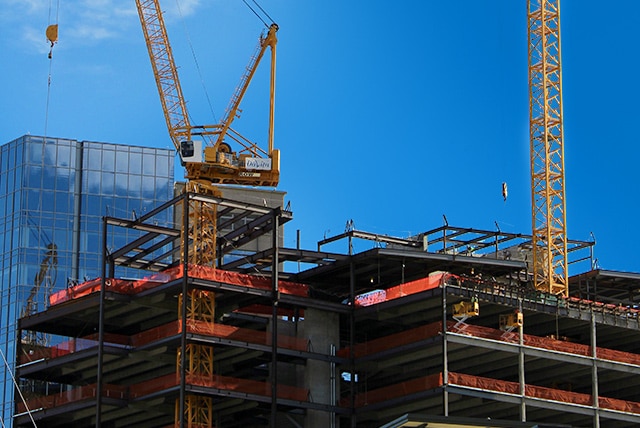
Bottom Climbing Unit
Climbing inside buildings is made possible by the bottom climbing unit. Climbing collars are used with a hydraulic power pack to lift the tower sections upward. The crane leaves Its foundation at the ground, and is completely supported by the structure of the building it is constructing. This leaves the lower levels of a building vacant for finish work, and at times occupancy before the building is completed.
+Diagram +Video | NEXT »
Tower Sections
A crane's tower mast is constructed of a series of tower crane sections. The structure of a section is reinforced by a braced square or truss. Sections are bolted together as the tower crane is erected. Access ladders are incorporated in the interior of the sections to enable workers to move up and down the crane.
| NEXT »
Bolts and Pins
Secure connections are an essential component of any tower crane and those connections are only as secure as the bolts and pins used on the crane. Anchor bolts must be of high tensile strength and pins and other bolts should be routinely re-torqued according to manufacturer specifications. Inspection of these connections are made on a routine schedule.
+Video | NEXT »
Tie-In
A tie-in secures the tower mast to a structure or framework and provides stability when the crane is under load or experiencing wind forces. The number of tie anchors are calculated by taking into account such factors as the type of crane, jib length, height under hook, and maximum out-of-service wind speed.
+Diagram | NEXT »
Undercarriage
The undercarriage of the crane acts as a base for the tower mast and surrounding lower structure. For a free-standing crane the undercarriage carries ballast weight, stabilizing the crane, while spreading out the load on the ground. Other fixed base cranes use large heavy foundations for stabilizing the crane. The crane tower is connected to foundation anchors embedded in re-enforced concrete.
+Diagram | NEXT »
Central Ballast
Central ballasts provide stability to the tower crane structure. Ballasts are made of concrete and come in modular sections that are stacked above the cross frame.
NEXT »
Base Plates/Bogies
Bogies are used for moving the crane on rails to allow the crane to cover more job site area. Rail mounted cranes use electric driven bogies, so the operator in the top of the crane can control the drive on the rail at the bottom of the crane. Stationary cranes can use corner base plates and economical corner pads under the undercarriage.
NEXT »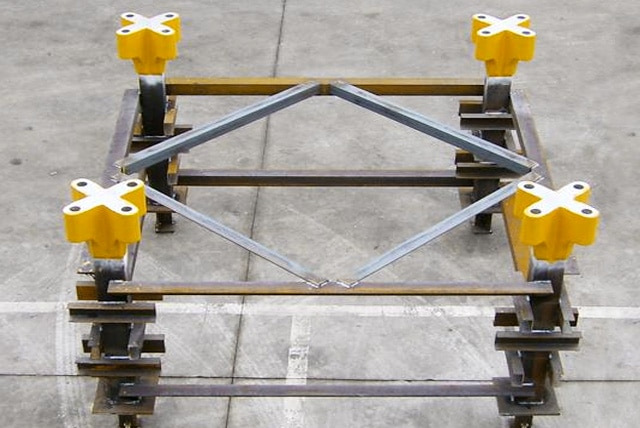
Foundation Anchors
Foundation anchors are steel posts embedded in re-enforced concrete that are bolted to the tower. These anchors provide a secure connection to prevent the crane from swaying or experiencing structural failure due to overload and wind forces.
NEXT »
- Horizontal Jib
- Trolley
- Hook Block
- Counter Jib
- Counterweight
- Hoist Unit
- Hoist Drum
- Tower Top
- Pendant Bars
- Trolley and Hoist Lines
- Slewing Assembly
- Operator Cab
- Slewing Ring
- Top Climbing Unit
- Bottom Climbing Unit
- Tower Sections
- Bolts and Pins
- Tie-In
- Undercarriage
- Knee Brace
- Central Ballast
- Cross Frame
- Base Plates
- Foundation Anchors
- Introduction



